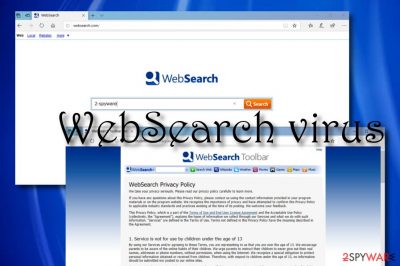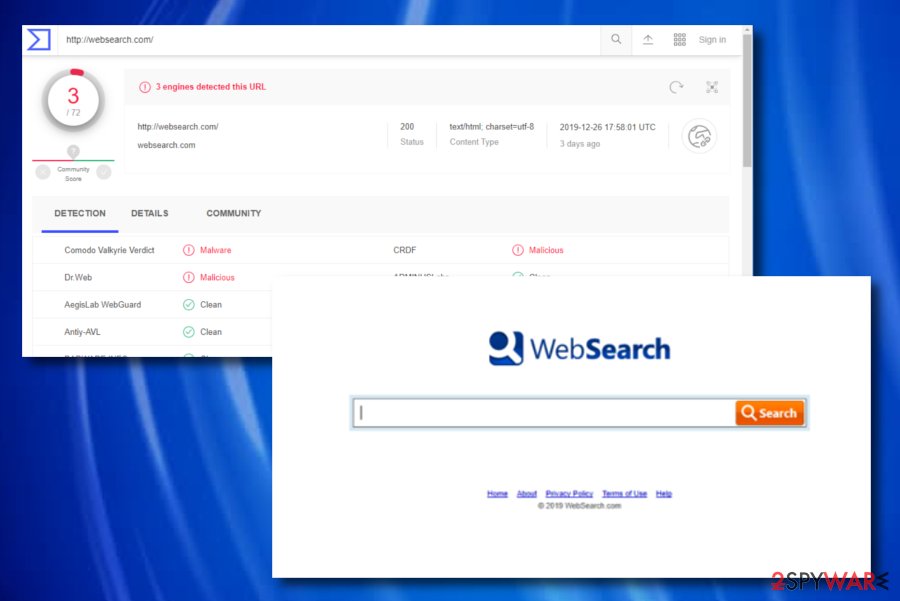WebSearch Toolbar (Removal Guide) - updated Dec 2019
WebSearch Toolbar Removal Guide
What is WebSearch Toolbar?
WebSearch – a browser hijacker that uses cookies for tracking users' online activities

WebSearch Toolbar, released by Crawler Group, is a browser-hijacking app that interferes with browser settings such as the search engine, homepage, and new tab URL bar. The aim of this PUP is to set your search provider to its own and force you to perform search queries via the new engine. This way you might encounter misleading information while using the app's services. If you have WebSearch installed on your computer and web browser, many annoying activities are yet to come. Besides modifying your browser apps, the browser hijacker[1] can also get you involved in unwanted advertising activities, redirecting to affiliate sources, and collecting non-personal data that relates to your browsing sessions.
| Name | WebSearch |
|---|---|
| Type | Potentially unwanted program |
| Sub-type | Browser hijacker |
| Danger level | Low. This product does not belong to the malware category |
| Tasks | The browser hijacker can interact with major browser settings such as the homepage, search engine, and new tab URL. Also, the PUP can get the users involved in advertising campaigns, redirecting activities, collect information that is related to the users' browsing sessions and online experience |
| Spreading | Software bundling is the main technique used to distribute these potentially unwanted programs. Also, they can arrive through infectious hyperlinks and advertisements that you meet online |
| Removal | You can get rid of the PUP with the help of antimalware software or by using manual guidelines (look for the instructions at the end of this article) |
| Fix tip | If the PUP has brought some type of corruption to your device, you can try fixing the damage with FortectIntego |
WebSearch virus is a term used to describe this intrusive app as it has a tendency to appear without the user's consent. The browser hijacker targets web browsers such as Google Chrome, Mozilla Firefox, Internet Explorer, Microsoft Edge, Safari, and appends changes to their major settings, fills them with bogus extensions and other objects.
WebSearch.com has its own Privacy Policy and Terms of Use which you should read before deciding to use this program's services. The developers claim that they use tracking technologies such as cookies[2] for identifying some data:
“Cookies” are small files that collect information that we use to track trends and patterns of how people search. We may send one or more cookies to your computer that uniquely identifies your user account or computer.
However, this is not all that WebSearch can collect. The browser hijacker can start recording information that is related to your surfing activities, habits, and experience. The developers might seek to know what types of websites you have recently visited, what offers are relevant for you the most, hyperlinks clicked, saved bookmarks, your IP.
Later on, WebSearch might use the collected information for getting you involved in targeted advertising campaigns where you will be provided with attractive-looking offers that relate to your search queries. Do not accept any of these deals as you might be encouraged to purchase a completely useless product or service.

Continuously, the developers of WebSearch might seek to redirect you to unknown locations that are also filled with various deals and offers. However, there is one thing potentially dangerous about redirecting. As a result, you might once end up on a malware-laden website that is filled with malicious content and get your device infected.
You should remove WebSearch from your computer and web browser to avoid all the potential risks that it brings. Also, you might not be able to use your web browser properly anymore, so if you want to reverse their settings and gain back full browsing quality, you will definitely have to get rid of the potentially unwanted program completely.
You can complete the WebSearch removal with the help of an antimalware tool or by using manual step-by-step guidelines. We have added some manual instructions at the end of the article if you are likely to see them.
Also, we cannot ignore the fact that WebSearch Toolbar might not come alone. It can be used as a source to distribute some type of malware or it can bring additional PUPs such as adware[3] to your computer system. If your machine has experienced some type of damage, you can try fixing the corruption with the help of a tool such as FortectIntego

It is possible to avoid browser hijacking
If you want to avoid the unexpected appearance of browser hijackers on each of your web browsers (Internet Explorer, Google Chrome, Mozilla Firefox, etc.), you should be very careful when installing free programs on your computer because there are hundreds that hold PUPs inside their software packages. Such programs can easily come from third-party downloading sources such as cnet.com, download.com, softonic.com, and similar ones.
Fortunately, you can do something to avoid browser hijackers and similar questionable applications. First of all, do not be impatient and read the Privacy Policy, End User's license agreement, and similar information that is provided about the app which you are looking forward to downloading. If you see that everything looks fine, then you should select Custom or Advanced installation of the freeware and avoid modes that are marked as Quick or Recommended.
This will help you to see all the “optional” components that may be trying to infiltrate your computer. Of course, you should opt-out of them if you want to avoid the secret installation process or browser-hijacking apps. Continuously, these products can get distributed via other locations such as unsecured ads and hyperlinks. For this purpose, be careful while browsing the web, do not click on anything that looks suspicious, and always have antimalware operating on your computer system so that you will be informed in case something rogue is trying to sneak into your device.
Remove WebSearch virus from your device and browsers
You can use the manual guiding steps that are provided below for the WebSearch removal process or you can employ reliable antimalware software. If you have been running into a lack of time or do not believe to have enough skills in the virus removal field, you can also choose to perform the process automatically.
According to security experts from Virusai.lt,[4] eliminating browser hijackers such as WebSearch virus with antimalware software is a safer and more effective option. However, if you are likely to, you still can try to get rid of the potentially unwanted program by completing steps by yourself.
Note that you will have to remove WebSearch from all of your infected web browsers such as Google Chrome, Mozilla Firefox, Internet Explorer, Microsoft Edge, and Safari. These locations might be filled with unwanted extensions and other objects, changes that also need to be eliminated for proper removal.
You may remove virus damage with a help of FortectIntego. SpyHunter 5Combo Cleaner and Malwarebytes are recommended to detect potentially unwanted programs and viruses with all their files and registry entries that are related to them.
Getting rid of WebSearch Toolbar. Follow these steps
Uninstall from Windows
To get rid of browser hijackers and other potentially unwanted content from your Windows device, apply the following instructing guidelines.
Instructions for Windows 10/8 machines:
- Enter Control Panel into Windows search box and hit Enter or click on the search result.
- Under Programs, select Uninstall a program.

- From the list, find the entry of the suspicious program.
- Right-click on the application and select Uninstall.
- If User Account Control shows up, click Yes.
- Wait till uninstallation process is complete and click OK.

If you are Windows 7/XP user, proceed with the following instructions:
- Click on Windows Start > Control Panel located on the right pane (if you are Windows XP user, click on Add/Remove Programs).
- In Control Panel, select Programs > Uninstall a program.

- Pick the unwanted application by clicking on it once.
- At the top, click Uninstall/Change.
- In the confirmation prompt, pick Yes.
- Click OK once the removal process is finished.
Delete from macOS
Remove items from Applications folder:
- From the menu bar, select Go > Applications.
- In the Applications folder, look for all related entries.
- Click on the app and drag it to Trash (or right-click and pick Move to Trash)

To fully remove an unwanted app, you need to access Application Support, LaunchAgents, and LaunchDaemons folders and delete relevant files:
- Select Go > Go to Folder.
- Enter /Library/Application Support and click Go or press Enter.
- In the Application Support folder, look for any dubious entries and then delete them.
- Now enter /Library/LaunchAgents and /Library/LaunchDaemons folders the same way and terminate all the related .plist files.

Remove from Microsoft Edge
To clean Microsoft Edge from unwanted changes and get rid of all rogue content that was added by the browser hijacker, complete the following guide.
Delete unwanted extensions from MS Edge:
- Select Menu (three horizontal dots at the top-right of the browser window) and pick Extensions.
- From the list, pick the extension and click on the Gear icon.
- Click on Uninstall at the bottom.

Clear cookies and other browser data:
- Click on the Menu (three horizontal dots at the top-right of the browser window) and select Privacy & security.
- Under Clear browsing data, pick Choose what to clear.
- Select everything (apart from passwords, although you might want to include Media licenses as well, if applicable) and click on Clear.

Restore new tab and homepage settings:
- Click the menu icon and choose Settings.
- Then find On startup section.
- Click Disable if you found any suspicious domain.
Reset MS Edge if the above steps did not work:
- Press on Ctrl + Shift + Esc to open Task Manager.
- Click on More details arrow at the bottom of the window.
- Select Details tab.
- Now scroll down and locate every entry with Microsoft Edge name in it. Right-click on each of them and select End Task to stop MS Edge from running.

If this solution failed to help you, you need to use an advanced Edge reset method. Note that you need to backup your data before proceeding.
- Find the following folder on your computer: C:\\Users\\%username%\\AppData\\Local\\Packages\\Microsoft.MicrosoftEdge_8wekyb3d8bbwe.
- Press Ctrl + A on your keyboard to select all folders.
- Right-click on them and pick Delete

- Now right-click on the Start button and pick Windows PowerShell (Admin).
- When the new window opens, copy and paste the following command, and then press Enter:
Get-AppXPackage -AllUsers -Name Microsoft.MicrosoftEdge | Foreach {Add-AppxPackage -DisableDevelopmentMode -Register “$($_.InstallLocation)\\AppXManifest.xml” -Verbose

Instructions for Chromium-based Edge
Delete extensions from MS Edge (Chromium):
- Open Edge and click select Settings > Extensions.
- Delete unwanted extensions by clicking Remove.

Clear cache and site data:
- Click on Menu and go to Settings.
- Select Privacy, search and services.
- Under Clear browsing data, pick Choose what to clear.
- Under Time range, pick All time.
- Select Clear now.

Reset Chromium-based MS Edge:
- Click on Menu and select Settings.
- On the left side, pick Reset settings.
- Select Restore settings to their default values.
- Confirm with Reset.

Remove from Mozilla Firefox (FF)
Remove dangerous extensions:
- Open Mozilla Firefox browser and click on the Menu (three horizontal lines at the top-right of the window).
- Select Add-ons.
- In here, select unwanted plugin and click Remove.

Reset the homepage:
- Click three horizontal lines at the top right corner to open the menu.
- Choose Options.
- Under Home options, enter your preferred site that will open every time you newly open the Mozilla Firefox.
Clear cookies and site data:
- Click Menu and pick Settings.
- Go to Privacy & Security section.
- Scroll down to locate Cookies and Site Data.
- Click on Clear Data…
- Select Cookies and Site Data, as well as Cached Web Content and press Clear.

Reset Mozilla Firefox
If clearing the browser as explained above did not help, reset Mozilla Firefox:
- Open Mozilla Firefox browser and click the Menu.
- Go to Help and then choose Troubleshooting Information.

- Under Give Firefox a tune up section, click on Refresh Firefox…
- Once the pop-up shows up, confirm the action by pressing on Refresh Firefox.

Remove from Google Chrome
To erase unexpected components from Google Chrome and restore all settings back to their primary positions, use these instructing steps.
Delete malicious extensions from Google Chrome:
- Open Google Chrome, click on the Menu (three vertical dots at the top-right corner) and select More tools > Extensions.
- In the newly opened window, you will see all the installed extensions. Uninstall all the suspicious plugins that might be related to the unwanted program by clicking Remove.

Clear cache and web data from Chrome:
- Click on Menu and pick Settings.
- Under Privacy and security, select Clear browsing data.
- Select Browsing history, Cookies and other site data, as well as Cached images and files.
- Click Clear data.

Change your homepage:
- Click menu and choose Settings.
- Look for a suspicious site in the On startup section.
- Click on Open a specific or set of pages and click on three dots to find the Remove option.
Reset Google Chrome:
If the previous methods did not help you, reset Google Chrome to eliminate all the unwanted components:
- Click on Menu and select Settings.
- In the Settings, scroll down and click Advanced.
- Scroll down and locate Reset and clean up section.
- Now click Restore settings to their original defaults.
- Confirm with Reset settings.

Delete from Safari
Remove unwanted extensions from Safari:
- Click Safari > Preferences…
- In the new window, pick Extensions.
- Select the unwanted extension and select Uninstall.

Clear cookies and other website data from Safari:
- Click Safari > Clear History…
- From the drop-down menu under Clear, pick all history.
- Confirm with Clear History.

Reset Safari if the above-mentioned steps did not help you:
- Click Safari > Preferences…
- Go to Advanced tab.
- Tick the Show Develop menu in menu bar.
- From the menu bar, click Develop, and then select Empty Caches.

After uninstalling this potentially unwanted program (PUP) and fixing each of your web browsers, we recommend you to scan your PC system with a reputable anti-spyware. This will help you to get rid of WebSearch Toolbar registry traces and will also identify related parasites or possible malware infections on your computer. For that you can use our top-rated malware remover: FortectIntego, SpyHunter 5Combo Cleaner or Malwarebytes.
How to prevent from getting browser hijacker
Protect your privacy – employ a VPN
There are several ways how to make your online time more private – you can access an incognito tab. However, there is no secret that even in this mode, you are tracked for advertising purposes. There is a way to add an extra layer of protection and create a completely anonymous web browsing practice with the help of Private Internet Access VPN. This software reroutes traffic through different servers, thus leaving your IP address and geolocation in disguise. Besides, it is based on a strict no-log policy, meaning that no data will be recorded, leaked, and available for both first and third parties. The combination of a secure web browser and Private Internet Access VPN will let you browse the Internet without a feeling of being spied or targeted by criminals.
No backups? No problem. Use a data recovery tool
If you wonder how data loss can occur, you should not look any further for answers – human errors, malware attacks, hardware failures, power cuts, natural disasters, or even simple negligence. In some cases, lost files are extremely important, and many straight out panic when such an unfortunate course of events happen. Due to this, you should always ensure that you prepare proper data backups on a regular basis.
If you were caught by surprise and did not have any backups to restore your files from, not everything is lost. Data Recovery Pro is one of the leading file recovery solutions you can find on the market – it is likely to restore even lost emails or data located on an external device.
- ^ What are browser hijackers?. Norton. Internet Security.
- ^ HTTP cookie. Wikipedia. The free encyclopedia.
- ^ What is Adware?. Kaspersky. Resource center.
- ^ Virusai.lt. Virusai. Security and spyware news.























